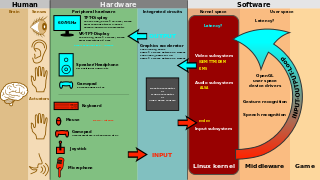Related Research Articles

Alan Curtis Kay is an American computer scientist best known for his pioneering work on object-oriented programming and windowing graphical user interface (GUI) design. At Xerox PARC he led the design and development of the first modern windowed computer desktop interface. There he also led the development of the influential object-oriented programming language Smalltalk, both personally designing most of the early versions of the language and coining the term "object-oriented." He has been elected a Fellow of the American Academy of Arts and Sciences, the National Academy of Engineering, and the Royal Society of Arts. He received the Turing award in 2003.

A graphical user interface, or GUI, is a form of user interface that allows users to interact with electronic devices through graphical icons and visual indicators such as secondary notation. In many applications, GUIs are used instead of text-based UIs, which are based on typed command labels or text navigation. GUIs were introduced in reaction to the perceived steep learning curve of command-line interfaces (CLIs), which require commands to be typed on a computer keyboard.

In the industrial design field of human–computer interaction, a user interface (UI) is the space where interactions between humans and machines occur. The goal of this interaction is to allow effective operation and control of the machine from the human end, while the machine simultaneously feeds back information that aids the operators' decision-making process. Examples of this broad concept of user interfaces include the interactive aspects of computer operating systems, hand tools, heavy machinery operator controls and process controls. The design considerations applicable when creating user interfaces are related to, or involve such disciplines as, ergonomics and psychology.
A heuristic evaluation is a usability inspection method for computer software that helps to identify usability problems in the user interface design. It specifically involves evaluators examining the interface and judging its compliance with recognized usability principles. These evaluation methods are now widely taught and practiced in the new media sector, where user interfaces are often designed in a short space of time on a budget that may restrict the amount of money available to provide for other types of interface testing.

Susan Kare is an American artist and graphic designer, who contributed interface elements and typefaces for the first Apple Macintosh personal computer from 1983 to 1986. She was employee #10 and creative director at NeXT, the company formed by Steve Jobs after he left Apple in 1985. She was a design consultant for Microsoft, IBM, Sony Pictures, Facebook, and Pinterest. As of 2023 Kare was an employee of Niantic Labs. As a pioneer of pixel art and of the graphical computer interface, she has been celebrated as one of the most significant designers of modern technology.
Interaction design, often abbreviated as IxD, is "the practice of designing interactive digital products, environments, systems, and services." While interaction design has an interest in form, its main area of focus rests on behavior. Rather than analyzing how things are, interaction design synthesizes and imagines things as they could be. This element of interaction design is what characterizes IxD as a design field, as opposed to a science or engineering field.

Lawrence Gordon Tesler was an American computer scientist who worked in the field of human–computer interaction. Tesler worked at Xerox PARC, Apple, Amazon, and Yahoo!.
In human–computer interaction, a cursor is an indicator used to show the current position on a computer monitor or other display device that will respond to input.

User interface (UI) design or user interface engineering is the design of user interfaces for machines and software, such as computers, home appliances, mobile devices, and other electronic devices, with the focus on maximizing usability and the user experience. In computer or software design, user interface (UI) design primarily focuses on information architecture. It is the process of building interfaces that clearly communicate to the user what's important. UI design refers to graphical user interfaces and other forms of interface design. The goal of user interface design is to make the user's interaction as simple and efficient as possible, in terms of accomplishing user goals.
Design thinking refers to the set of cognitive, strategic and practical procedures used by designers in the process of designing, and to the body of knowledge that has been developed about how people reason when engaging with design problems.
Universal usability refers to the design of information and communications products and services that are usable for every citizen. The concept has been advocated by Professor Ben Shneiderman, a computer scientist at the Human-Computer Interaction Lab at the University of Maryland, College Park. He also provided a more practical definition of universal usability – "having more than 90% of all households as successful users of information and communications services at least once a week." The concept of universal usability is closely related to the concepts of universal design and design for all. These three concepts altogether cover, from the user's end to the developer's end, the three important research areas of information and communications technology (ICT): use, access, and design.
Faceted search augments lexical search with a faceted navigation system, allowing users to narrow results by applying filters based on a faceted classification of the items. It is a parametric search technique. A faceted classification system classifies each information element along multiple explicit dimensions, facets, enabling the classifications to be accessed and ordered in multiple ways rather than in a single, predetermined, taxonomic order.
TinyMUCK or, more broadly, a MUCK, is a type of user-extendable online text-based role-playing game, designed for role playing and social interaction. Backronyms like "Multi-User Chat/Created/Computer/Character/Carnal Kingdom" and "Multi-User Construction Kit" are sometimes cited, but are not the actual origin of the term; "muck" is simply a play on the term MUD.
Peachpit is a publisher of books focused on graphic design, web design, and development. Peachpit's parent company is Pearson Education, which owns additional educational media brands including Addison-Wesley, Prentice Hall, and New Riders.

Aaron Marcus is an American user-interface and information-visualization designer, as well as a computer graphics artist.
In computing, a natural user interface (NUI) or natural interface is a user interface that is effectively invisible, and remains invisible as the user continuously learns increasingly complex interactions. The word "natural" is used because most computer interfaces use artificial control devices whose operation has to be learned. Examples include voice assistants, such as Alexa and Siri, touch and multitouch interactions on today's mobile phones and tablets, but also touch interfaces invisibly integrated into the textiles furnitures.
Susan Leigh Star (1954–2010) was an American sociologist. She specialized in the study of information in modern society; information worlds; information infrastructure; classification and standardization; sociology of science; sociology of work; and the history of science, medicine, technology, and communication/information systems. She commonly used the qualitative methods methodology and feminist theory approach. She was also known for developing the concept of boundary objects and for contributions to computer-supported cooperative work.

Susan Diane Wojcicki is an American business executive who was the chief executive officer (CEO) of YouTube from 2014 to 2023. Her net worth was estimated at $765 million in 2022.
Susan Catherine Herring is an American linguist and communication scholar who researches gender differences in Internet use, and the characteristics, functions, and emergent norms associated with language, communication, and behavior in new online forms such as social media. She is Professor of Information Science and Linguistics at Indiana University Bloomington, where she founded and directs the Center for Computer-Mediated Communication. In 2013 she received the Association for Information Science & Technology Research Award for her contributions to the field of computer-mediated communication. She has been a fellow at the Center for Advanced Study in the Behavioral Sciences at Stanford University. Herring also founded and directed the BROG project.
Responsive computer-aided design is an approach to computer-aided design (CAD) that utilizes real-world sensors and data to modify a three-dimensional (3D) computer model. The concept is related to cyber-physical systems through blurring of the virtual and physical worlds, however, applies specifically to the initial digital design of an object prior to production.
References
- ↑ "Amazon Book List". Amazon. Retrieved 5 July 2012.
- ↑ Weinschenk, Susan. "About Susan". Archived from the original on 17 July 2012. Retrieved 5 July 2012.
- ↑ "Psychology Today" . Retrieved 21 January 2012.
- ↑ "Pearson Publishing".
- ↑ WorldCat
- ↑ WorldCat
- ↑ WorldCat
- ↑ WorldCat
- ↑ WorldCat